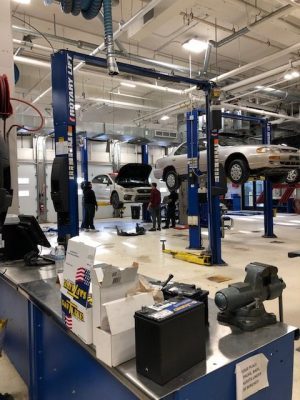Prevent the polar vortex from damaging your aging vehicle

Automotive students working under the hood of a car in the ECC lab.
If you take a bus or drive your own car for transportation, that vehicle is responsible for making sure you can get to the places you need to be. When weather conditions outside plummet to record-breaking temperatures in the middle of the winter, relying on a vehicle becomes more complicated than just turning your key in the ignition and driving.
On Jan. 30, Elgin went through a deep freeze with dangerous temperatures as low as 20 below zero. This polar vortex reached the longest sub-zero streak than ever before in the Chicago area with a record-breaking 52 hours. Bitter temperatures as cold as ones in Antarctica caught some car owners in a frustrating situation that they were not prepared for.
First-year student at Elgin Community College Sierra Adams didn’t have any luck starting her car during the first day of the polar vortex.
“I tried starting it a couple of times in the morning, but it just wouldn’t turn over,” Adams said. “There was nothing we could do. My sister had to miss work, and I had to cancel plans with my friends and stay home all day.”
Adams said it took two days until her 2002 Ford Taurus was able to defrost enough to start the engine. She says the car will still act weird while driving, which gives Adams a feeling of uncertainty about getting to school every day.
This was a very common situation for many people in the area that own cars any more than five years old. Associate Professor of Automotive Technology Leonard Fitzpatrick describes this as a marginal battery problem that is often noticed in extreme temperatures.
“We use this weather as an example for how unexpected things can happen with automotive vehicles very quickly,” Fitzpatrick said. “It began a lot of discussions about why students couldn’t get their cars started and the conclusion was a lot of bad batteries. That’s what it takes for marginal batteries to get pushed over the edge.”
There’s no way to know for sure where you will be when your car battery decides to give up. It’s a risk many people are willing to take, especially when they don’t see any warning lights immediately popping up on the dashboard. According to Fitzpatrick, there are signs your car may need attention beyond what your vehicle’s programmed computer system can recognize.
“Eventually these car batteries will fail,” Fitzpatrick said. “It’s up to us to make sure that doesn’t happen while its 20 degrees below. You want to do anything to avoid the risk of being stranded outside trying to replace an old battery.”
In each and every vehicle, there is an owner’s manual provided that identifies a specific maintenance service schedule to follow for keeping your car in the best condition. For any car owner, it’s very important your vehicle gets professionally inspected for any marginal problems before winter starts. These inspections are an opportunity to take care of preventative maintenance that is tremendously beneficial for limiting issues that cause breakdowns in the winter. Preventative maintenance won’t prevent all breakdowns, but it highly increases your odds of making it through the winter without one, according to Fitzpatrick.
“Vehicles are usually the second biggest investment we make in our lives,” said Fitzpatrick. “We, unfortunately, have the tendency to ignore our vehicles until something breaks. Instead, we should be encouraged to focus on maintaining our cars and preventing marginal problems.”
According to Fitzpatrick, preventative maintenance gives car owner’s a magnified view at various potential problems that are difficult to see if you are not an automotive expert. Thorough inspections will pay close attention to all rubber components in your car making sure they don’t find any cracking or breaking. They also focus on the quality of your belts and hoses, the vehicle’s battery life and also check engine fluids to ensure the vehicle is safe. An inspection before winter helps eliminate the threat of these red flags before you put yourself in a dangerous situation out on the road in frosty temperatures.
“I tried to limit going out at all when it was that cold out,” Fitzpatrick said. “When it’s minus 20 [degrees], and then factoring in the windchill on top of that, a problem on the road that would normally be a minor inconvenience suddenly has potential to become a life or death situation if you can’t find help.”
According to Charlene Sligting, AAA Traffic Safety Manager, the polar vortex exposed many different roadside complications that drivers in the Chicago area were not prepared for. There were many stranded drivers that needed to be prioritized first for assistance because the weather temperatures were so life-threatening.
“I encouraged everyone not to go out unless it was absolutely an emergency,” Sligting said. “If you did need to drive somewhere, [you had to] make sure you were prepared with safety aids like warm blankets, gloves and winter hats. Also, [you had to] make sure you had a set of jumper cables with you, along with a supply of water and snacks.”
The average car out on the road right now is 11 years old, and many people are unaware of how quickly a vehicle that age can break down in the winter, according to Sligting. It’s also unfortunate that people are convinced that because they are excellent drivers, they will completely avoid any serious danger.
“It’s near impossible to predict when you will eventually need roadside assistance,” Sligting said. “When we received calls during the really cold weather, we always told them to stay in their vehicles to stay warm. The reality was many people didn’t have any kind of survival kit to depend on, and many were running out of gas very quickly which leaves them in a helpless situation until assistance arrives.”
Record-breaking temperatures this winter showed the importance of being consistent with maintaining your vehicle. Considering the danger of marginal problems in extreme temperatures is a way to help you judge the overall risk of leaving your house or not. If the weather conditions outside are dangerous and you still need to drive somewhere, be sure you are prepared. Sligting recommends paying close attention to your fuel gauge so that it doesn’t go under a half tank, and always remember that even experienced drivers are always vulnerable to a hindrance on the road.

I’m studying journalism, I’ve been at ECC for three years, and I decided to join The Observer so I can have a way to connect with my community college...







